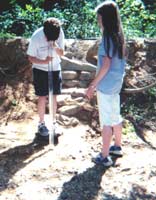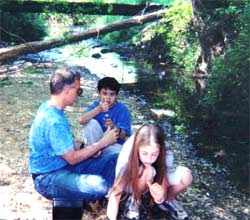Stars and STEM Stories
Students Fill in the GAPS
Soil scientists from the NASA Goddard Space Flight Center in Greenbelt, MD, are so impressed with GLOBE student data from Jefferson Middle School in Winston-Salem, NC, USA, that they've invited the students to help them with their General Purpose Atmosphere Plant Soil Simulator (GAPS).
GAPS is a simulation model the scientists are using to investigate the soil-plant-atmosphere system. They are inputting GLOBE data, including variables like soil moisture from the Jefferson students, to set up the model. They will also GLOBE data to test whether the model's predictions are accurate.

"Once we feel confident that the model works, then we can start making predictions about what would happen under different scenarios," says Dr. Elissa Levine, GLOBE's Principal Investigator for Soil Characterization and a Goddard soil scientist. Levine says scientists could use the model to look at changes over time and to make predictions about growing seasons, flooding, and a host of other factors that influence and are influenced by climate and climate change.
The Goddard team is looking at data from the Jefferson students' completed three soil characterizations. "They're a researcher's dream: committed, curious and careful," says Goddard soil scientist Jessica Robin, of the Jefferson students. "We feel fortunate to have them as part of our research project."

GLOBE teacher John Cardarelli plans to continue expanding his classes' soil studies. Soil characterization is part of North Carolina's requirements for sixth-grade science, and Cardarelli finds GLOBE the perfect teaching vehicle.
In addition to his sixth-grade classes, Cardarelli uses GLOBE soil, hydrology and atmosphere protocols with his extra-curricular science club and with his "Envirothon" teams. The annual Envirothon is a national multiple-choice competition on soil, water, forestry, wildlife and "current environmental issues." Cardarelli's teams - made up of five students from the 6th, 7th, and 8th grades - made it to the state-level competition.
A $1,000 grant from the John Muir Foundation got Cardarelli and his students the equipment they needed for their GLOBE protocols. Now he can envision expanding his students' work.
"The science in GLOBE is real and down-to-earth at the same time. It's a far cry from textbook learning and in brings the concepts to life," Cardarelli said. "It's great when it matches your curriculum. And we're happy that the scientists [at Goddard] are finding our data helpful."
Cardarelli's students last year took soil samples from a wooded area on their school grounds and from nearby Bethabara Park. The park remains similar to as it was in 1753 when Moravian settlers came to the area from Pennsylvania. The students also monitor two streams there and are doing land cover studies in the hills and old-growth forests within the park. Cardarelli would like to help his students gain a scientific understanding of the park, including changes over the years.
"It's a whole world to explore, a world we're not familiar with, and I'm looking forward to that," Cardarelli said.
12 June 2002





